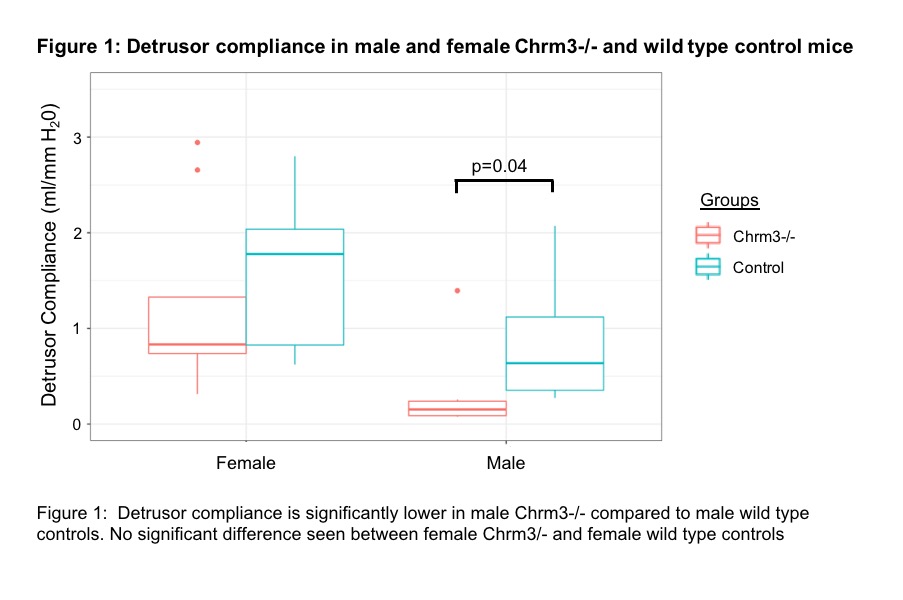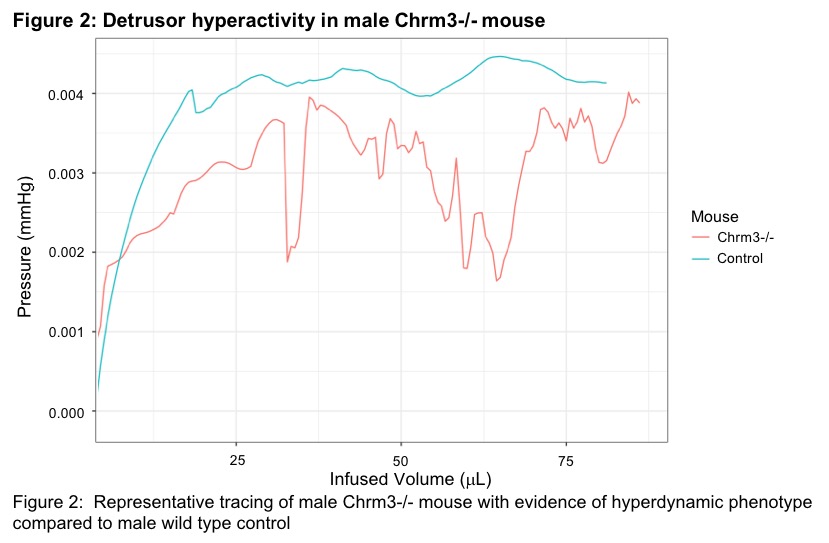Developing a Non-Surgical Mouse Model of Neuropathic Bladder
Catherine S. Forster, MD, MS, Olivia Lamanna, BS, Michael H. Hsieh, MD, PhD.
Children's National Medical Center, Washington, DC, USA.
Background: One of the most commonly used mouse model of neuropathic bladder is generated through surgical spinal cord injury. However, this model is technically challenging, time consuming, and yields inconsistent phenotypes. A genetic model of neuropathic bladder would facilitate research in this area. Chrm3-/- (B6N.129S6(B6J)-Chrm3 tm1Jwe /J) mice lack muscarinic acetylcholine receptor 3 alleles, resulting in the underdevelopment of the smooth muscle necessary for normal bladder function. Therefore, these mice may be a novel option for development of non-surgical models of neuropathic bladder. The goal of this project was to use voided spot assays and sedated cystometry to determine whether the Chrm3-/- mice exhibit a neuropathic bladder phenotype.
Methods: Male and female Chrm3-/- mice and age-matched littermate controls were individually isolated for 4 hours in wire-bottom cages above filter paper that allowed the collection, visualization and quantification of void spots. Voiding volumes were measured based on an established standard curve. The voided area was measured in triplicate using ImageJ software. Sedated cystometry was completed using PowerLab to measure detrusor pressure and calculate compliance. Cystometry was done in triplicate on different days. A t-test, or Mann-Whitney U as appropriate, was used to compare values between groups.
Results: 2 voided spot assays were obtained from 12 mice (6 Chrm3-/- and 6 controls). There was no difference in mean total urine volume between Chrm3-/- mice and controls, (433.2+218.2, 555.2+341.8, p=0.40), or mean total number of voids (20+25, 8+6, p= 0.13). When compared by gender, female Chrm3-/- mice had significantly lower mean total urine volumes compared to female wild type controls as measured by both the voided spot assay (292.9+50.9, 702+ 42.5μL, p<0.01). There was no difference in the mean total urine volumes between the male Chrm3-/- and controls. (550.1+ 240.3, 445.1+441.3μL, p=0.69). (figure 1). While median detrusor compliance was not significantly different between groups (1.38±1.36 mL/mm H20 for controls, 0.74±1.00 mL/mm H20 for Chrm3-/-, p=0.07) male Chrm3-/- had significantly lower median compliance compared to male wild type controls (0.15±0.15 mL/mm H20, 0.63±0.77 ml /mm H20, p=0.04). There was no significant difference in median detrusor compliance in the females (1.89±1.06 for Chrm3-/-, 0.83± 0.59 ml/mm H20, p=0.18). Male Chrm3-/- occasionally exhibited detrusor hyperactivity. (Figure 2)
Conclusion: Female, but not male, Chrm3-/- mice have significantly lower urine volumes compared to age-matched littermate controls, while male Chrm3-/- have lower compliance compared to littermate controls. Chrm3-/- mice may be a useful model of neuropathic bladder.
Figure 1
Figure 2: 

Back to 2019 Abstracts




